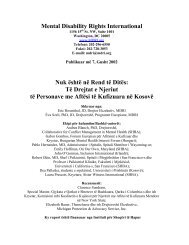Torture not Treatment - Disability Rights International
Torture not Treatment - Disability Rights International
Torture not Treatment - Disability Rights International
You also want an ePaper? Increase the reach of your titles
YUMPU automatically turns print PDFs into web optimized ePapers that Google loves.
TORTURE NOT TREATMENT<br />
Human <strong>Rights</strong> Committee be in compliance with their responsibilities as stated in the state<br />
regulations; ensure that restraint devices used be ―clearly articulated‖ – including conditions for<br />
their use. As of this writing, JRC continues to be certified to use Level III punishments on its<br />
residents.<br />
Conclusions and Recommendations<br />
The intentional infliction of severe pain perpetrated against children and adults with disabilities<br />
by JRC violates the UN Convention against <strong>Torture</strong>. Aversive treatment is used to inflict pain as<br />
punishment to coercive and intimidate people with disabilities to change their behavior. The<br />
legal framework which allows such treatment is discriminatory – as it permits such practices to<br />
be perpetrated only against individuals with disabilities. The dehumanization and<br />
depersonalization of children at JRC by way of state-sanctioned punishment with electric shocks,<br />
4-point restraint boards, mock assaults, food deprivation, shock chairs and shock holsters fosters<br />
an environment ripe for abuse and one that would <strong>not</strong> be tolerated – especially against children -<br />
in any other setting. These practices induce extreme and severe pain and suffering on an<br />
extremely vulnerable population of children and adults with disabilities and constitute illtreatment<br />
or torture against the UN Convention against <strong>Torture</strong>.<br />
No population is more vulnerable to abuse than children with disabilities detained in an<br />
institution. This population needs the strongest level of international protection to protect them<br />
against abuse. For this population, the use of electric shock, long-term restraint, and other<br />
aversives used by JRC constitute human rights violations that are even more serious than<br />
corporal punishment in a school, where children eventually go home to friends and family in the<br />
community. The UN Special Rapporteur on <strong>Torture</strong> has stated that corporal punishment<br />
constitutes inhuman and degrading treatment. For a population detained in an institution, such as<br />
JRC, the vulnerability is much greater -- and the experience of pain and suffering is likely more<br />
extreme. Thus, severe pain perpetrated against this population should be viewed as fully<br />
tantamount to torture. According to Nowak, ―[t]he powerlessness of the victim is the essential<br />
criterion which the drafters of the Convention had in mind when they introduced the legal<br />
distinction between torture and other forms of ill-treatment.‖ 225<br />
The UN Convention against <strong>Torture</strong> prohibits practices that amount to the intentional infliction<br />
of severe pain. It could be argued that any one aversive practice, used in a mild form, does <strong>not</strong><br />
entail severe pain. MDRI does <strong>not</strong> and can<strong>not</strong> attempt to define exactly when the repeated use of<br />
restraint adds up to a violation of international human rights law or exactly what level of<br />
electricity might constitute ill-treatment or torture. The practice of ill-treatment or torture is<br />
considered so serious that the UN Committee Against <strong>Torture</strong> (CAT) has recommended<br />
governments adopt clear and absolute standards to protect against abuse.<br />
41




